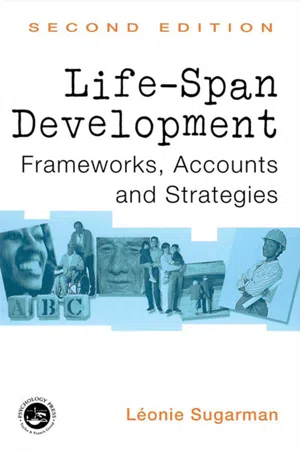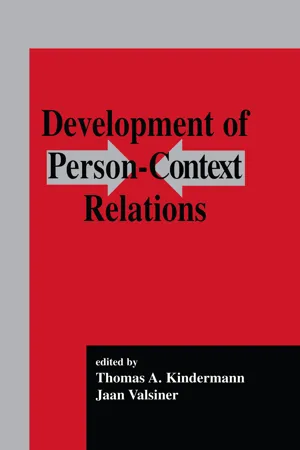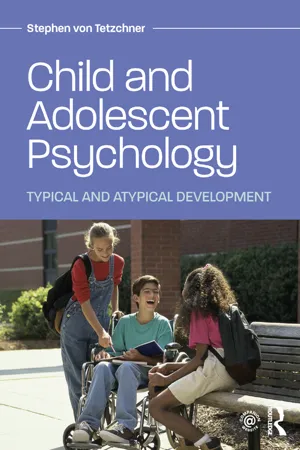Continuity vs Discontinuity
Continuity vs Discontinuity refers to the debate in psychology about whether development occurs gradually and smoothly (continuity) or in distinct stages (discontinuity). Proponents of continuity argue that development is a cumulative process, while supporters of discontinuity believe that development occurs in distinct, qualitative stages. This debate has implications for understanding human growth and change across the lifespan.
7 Key excerpts on "Continuity vs Discontinuity"
- eBook - ePub
Life-Span Development and Behavior
Volume 10
- Paul B. Baltes, David L. Featherman, Richard M. Lerner, Paul B. Baltes, David L. Featherman, Richard M. Lerner(Authors)
- 2014(Publication Date)
- Psychology Press(Publisher)
...Others have dealt with the issue of continuity as stability (see Brim & Kagan, 1980; Emde & Harmon, 1984; Lerner, 1984). Our discussion of continuity and discontinuity is broad in that it focuses on a number of relevant topics. The question of whether continuity (or discontinuity) is possible, given the theories on time, allows us to consider the continuity issue again. To anticipate our discussion, the concept of relative and dialectic time (Riegel, 1977) and history (Gergen, 1977) requires that we reconsider whether the notion of continuity is a reasonable possibility for developmental processes. Support for the concern over the adequacy of continuity, independent of measurement issues, can be found in other life sciences such as evolutionary biology. Finally, given the more recent work on catastrophe and chaos, it may be possible to integrate our interest in development with theories of discontinuity. Our approach here is to explore the dual issues of time (including history) and development. It is from a discussion of our general understanding of time that we approach the issue of discontinuity and continuity in development. In the following description, we present first the major differences in how Western society has conceptualized time. This is done so as to characterize how conceptions of time affect our general notion of change since, as is argued, all change involves time as well as time being defined by change (Fraisse, 1964). Moreover, it is necessary to argue that most psychological phenomena involve time since such phenomena occur over time. From this we demonstrate how different models of time impact on different developmental theories. Here the issue of continuity both in time and in development is considered. Although we address developmental issues through the understanding of time, it is important to recognize that other conceptualizations have also touched upon issues of time and their impact on causality and continuity...
- eBook - ePub
Life-span Development
Frameworks, Accounts and Strategies
- Leonie Sugarman(Author)
- 2004(Publication Date)
- Routledge(Publisher)
...Static continuity implies being unchanging, uniform, and remaining the same – not a notion that is very applicable to life-span development. Dynamic continuity, by contrast, starts with the idea of a basic structure, which persists over time but which allows for a variety of changes to occur within the context provided by that structure. Levinson’s (1986; Levinson et al., 1978) concept of the life course as the evolution of a life structure, whilst discussed earlier under the heading of development as the management of a series of developmental tasks is, none the less, compatible with this perspective. Atchley (1989) makes a distinction between internal (intrapsychic) and external (environmental) structures and proposes that in making adaptive choices, middle-aged and older adults attempt to preserve and maintain these structures, preferably through the use of continuity: “by applying familiar strategies in familiar arenas of life” (Atchley, 1989, p. 183). In this way we are able to maintain a continuous sense of who we are and explain our current behaviour and aspirations as in some way connected to what has come before. External continuity Whilst Gergen, in his aleatory change model of development, emphasised the ways in which external influences change and vary, continuity theory explores their continuities, that is, “the persistence of a structure of relationships and overt behavior” (Atchley, 1989, p. 185). External continuity is evidenced by being in familiar environments, undertaking familiar activities and skills, and interacting with familiar people (Caspi, Bem, & Elder, 1989). Key exemplifications include: Continuity of environments. This refers to the fact that we tend to choose environments that we believe will be compatible with our skills and disposition. In turn, our skills and disposition will have been honed by experience in particular environments...
- eBook - ePub
Personality Psychology
A Student-Centered Approach
- James (Jim) A. McMartin(Author)
- 2016(Publication Date)
- SAGE Publications, Inc(Publisher)
...First, the individual explores the difficult experience in depth, remembering what it felt like, how it came about, what it led to and might still lead to, and how this negative experience fits into his or her total life story. Second, the individual creates and commits to a positive resolution of the incident. Research indicates the first step leads to personal growth and the second to happiness (McAdams & McLean, 2013). Two theoretical orientations have contributed to our understanding of personality at the level of life narratives. Both orientations—the humanistic/existential and the psychodynamic—assume that personality change at this level is possible. As McAdams (1994) correctly points out, however, data on this point are virtually nonexistent. In other words, these theoretical views are interesting and important, but they are difficult to test empirically. We conclude the book, then, with answers to the question of continuity and change of personality in adulthood from theorists whose backgrounds as psychotherapists lead them to believe that motivated adults are able to change and create more satisfying stories of their lives. Humanistic and Existential Approaches to Continuity and Change The Fully Functioning Person Perhaps the major reason I am willing to take chances is that I have found that in doing so, whether I succeed or fail, I learn. Learning, especially learning from experience, has been a prime element in making my life worthwhile. Such learning helps me to expand. So I continue to risk.… It seems to me that I am still — inside—the shy boy who found communication very difficult in interpersonal situations. … That boy is still very much part of me. —Carl Rogers at age 75 (1980, pp. 78, 80) These quotes from Carl Rogers illustrate some of his personal experiences with continuity and change in his personality...
- eBook - ePub
The Psychological Development of Girls and Women
Rethinking change in time
- Sheila Greene(Author)
- 2014(Publication Date)
- Routledge(Publisher)
...Not only are people shaped by past: events and by their interpretations of past events, they also are shaped by their expectations of the future. Their experience of being in the world is profoundly influenced by the culture and historical period they find themselves in, by its discourses concerning personhood, the self and the significant achievements and goals expected of a person of their sex, age and social location. The self is experienced as both stable and in flux and the flow of events and of the changing contents of consciousness are inevitable features of lived experience. Not all branches of psychology incorporate this aspect of human life and experience into their accounts of psychological functioning. To some extent what emerges from examination of tensions and debates within developmental psychology is indeed an anti-developmental developmental psychology. It is anti-developmental in not endorsing a view of psychological change across the life course as propelled by fixed and universal internal processes, whether they are genes or cognitive schemas. The need for a developmental perspective remains, however, if one defines the developmental perspective broadly as that associated with the branch of psychology, which is attempting to understand the nature of change occurring across the life span, and that recognizes the role of history and time in the construction of the person (whether that history be actual events or psychic constructions of events). This history is a complex mix of the personal, the contextual and the transactional. Also, history is only part of the developmental story since the developmental orientation should also address the time-dependent nature of human existence, the manner in which we all hnd ourselves located in a stream of time, consisting — in our particular cultural perspective — of the past, the present and the future...
- eBook - ePub
- Thomas A. Kindermann, Jaan Valsiner, Thomas A. Kindermann, Jaan Valsiner(Authors)
- 2013(Publication Date)
- Psychology Press(Publisher)
...Introduction: Individual Development, Changing Contexts, and the Co-Construction of Person—Context Relations in Human Development Thomas A. Kindermann Portland State University Jaan Valsiner University of North Carolina at Chapel Hill DOI: 10.4324/9780203773840-1 Traditionally, developmental psychology has its focus on individuals. Developmentalists aim to describe regularities in individuals’ change and development across time, to explain the processes and mechanisms that are involved in producing change and regularity, and, eventually, to design strategies for optimization and modification of developmental pathways. Although the role of contexts has always been of central concern for these purposes, it is nevertheless surprising to note that, compared to the effort devoted to individuals, relatively little attention has been paid to the study of the nature and organization of their contexts. This volume is an exploration of the idea that the way we describe and explain human development will be closely tied to our understanding of what contexts are, how individuals and contexts become influential for one another, what contexts do to and with individuals, and how contexts and their influences change themselves across time. A major theme is the issue of whether the traditional dichotomy between individuals and their contexts may be artificial, perhaps culturally biased, and, after psychologists have adhered to it for about a century, may have become an impediment to increasing our understanding of developmental processes. Recent trends in developmental psychology propagate the study of ecological systems (Bronfenbrenner, 1989 ; Bronfenbrenner & Crouter, 1983 ; Ford & Lerner, 1992 ; Sameroff, 1983 ; Wachs, 1992 ; Wohlwill, 1983), the study of relationships between people and their environment (Hinde, 1992 ; see also Emde, 1994 ; Maccoby, 1992), or the study of co-constructive processes in human development (Valsiner, 1987, 1989 ; Winegar & Valsiner, 1992)...
- eBook - ePub
Child and Adolescent Psychology
Typical and Atypical Development
- Stephen von Tetzchner(Author)
- 2018(Publication Date)
- Routledge(Publisher)
...For instance, it has been known for a long time that children start speaking during their first year of life. In medieval times, it was assumed that children would begin to speak even if they didn’t hear speech, an assumption that is no longer accepted (O’Neill, 1980). In traditional developmental science, it is not the children who change throughout history but theories and empirical knowledge. In critical psychology there is no accumulated knowledge: children change when the theories change, because both are social constructs (Burman, 2017; Morss, 1996). The critical perspective represents a radical break with the very foundation of developmental psychology, not least because it rejects the established understanding of the concept “development.” There are relatively few critical psychologists and the critical approach has had only a limited influence on developmental psychology and the study of children. It has had more influence on the understanding of childhood as a sociological phenomenon, and especially in relation to variation in family structure and gender roles. However, questions raised by this perspective have been useful as counterweights to established views in developmental psychology and contributed to a more holistic appreciation of children in a social setting. DISTINGUISHING BETWEEN THEORIES This brief introduction demonstrates the considerable variation in theoretical approaches to developmental psychology, but also the many facets of children’s capacities and the complexity of the developmental process. The theories differ but also encompass many similarities in their ways of describing development as a process of adaptation. Piaget (1952) and Freud (1916) both emphasize conflict as a driving force in devel opment, but very different forms of conflict. In Piaget’s theory, the conflicts are between elements of the child’s perception of its surroundings, and the conflicts lead to integration of knowledge and cognitive development...
- eBook - ePub
From Instinct to Identity
The Development of Personality
- Louis Breger(Author)
- 2017(Publication Date)
- Routledge(Publisher)
...chapter one The Developmental Perspective The development of human personality is one of those grand topics—the concern of philosophers, novelists, psychologists, and theologians (not to mention parents) for centuries. All cultures and societies contain beliefs or theories about the psychological development of their people. Such beliefs or theories, which are usually not stated in any formal sense, are embodied in child-rearing practices; social institutions such as schools; beliefs about human nature, man’s “instincts” and how they can be legitimately expressed or how they must be controlled; the sorts of expectations held for children; and a host of other ideas, laws, values, and social practices. Such views enable parents to raise their children, and institutions to influence them, so that they become functioning members of their societies. There are, thus, a great number of theories and ideas about personality development, ranging from the most abstract philosophical views to the “theory” implicit in the way a peasant mother tends her child. There is no way in which all of these could be covered in a single book and I will make no attempt to do so. Rather, I will trace the development of personality as seen from a particular perspective. The overriding focus will be on the growth of self, from the sense- and action-dominated self of infancy to the formation of identity in adolescence and early adulthood. Attention will be directed at the evolutionary heritage of man, the centrality of emotion in human relationships, the role of fantasy, play, and dreams, unconscious processes, repression, and moral development...






